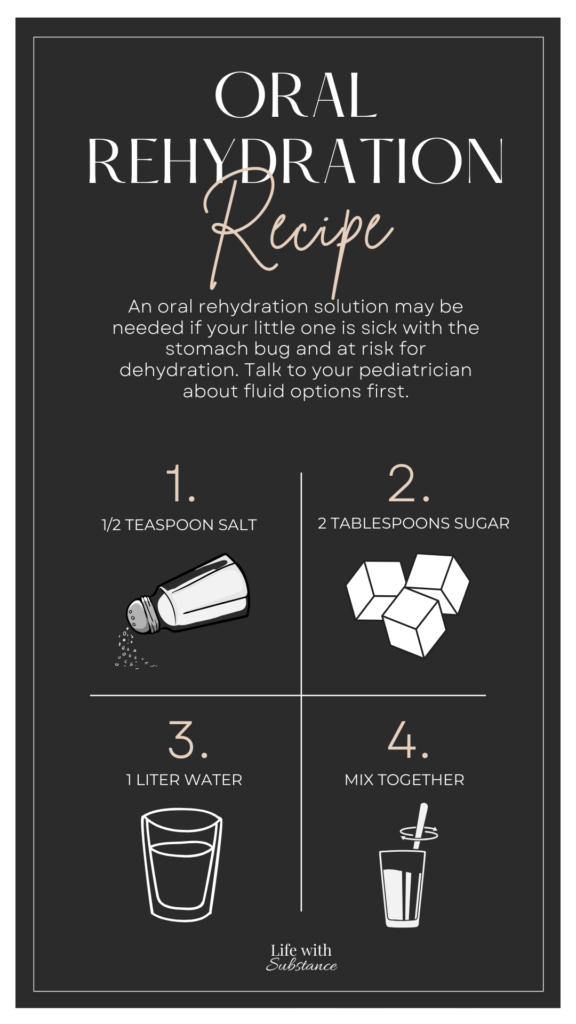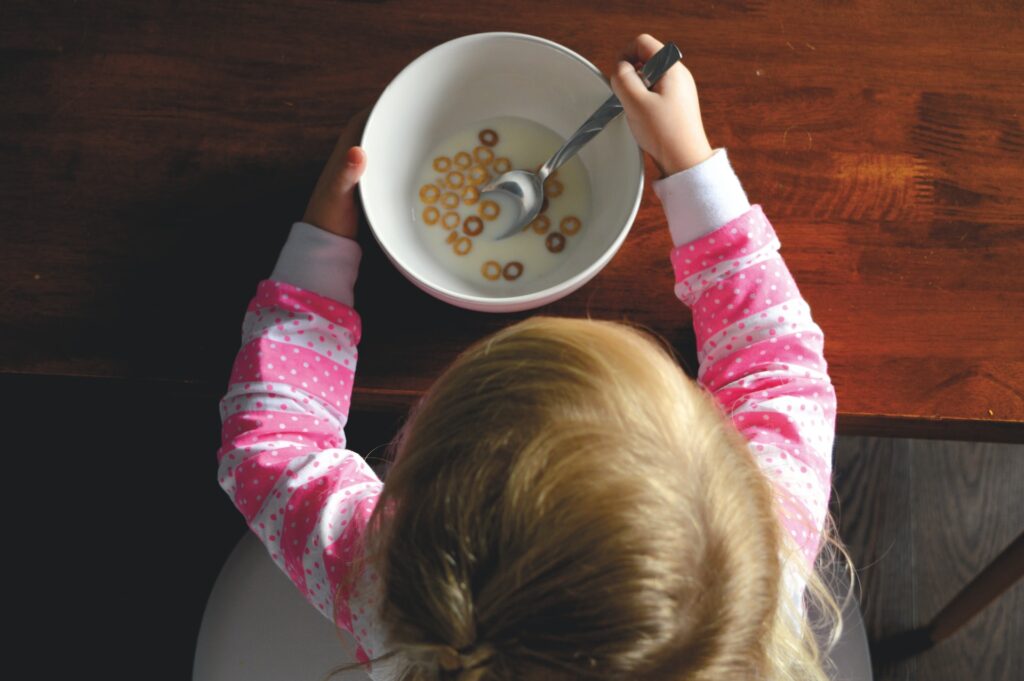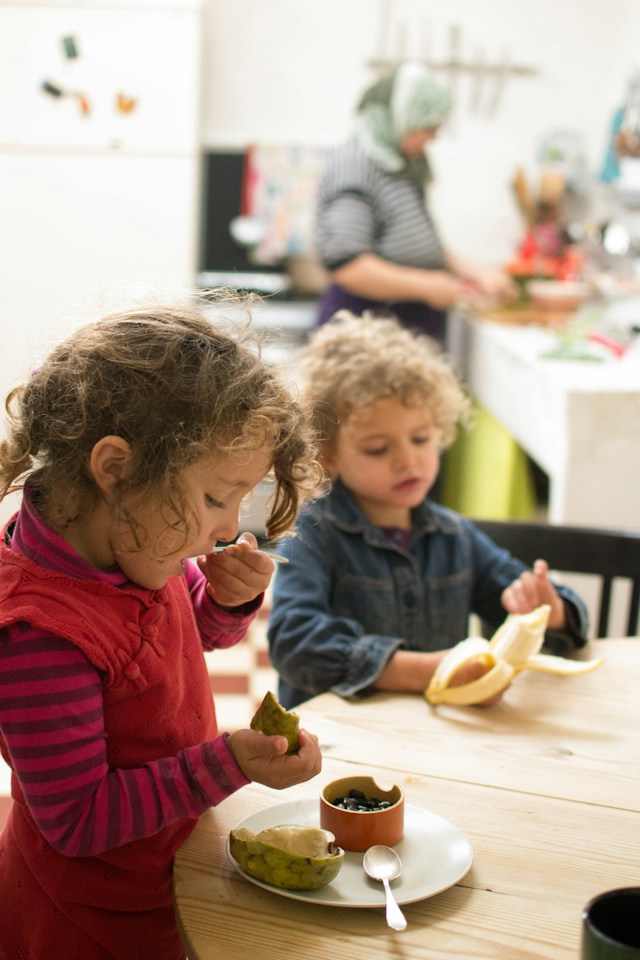This post may contain affiliate links. If you shop from one of our links, we may earn a commission.
I have survived having 3 kids go through daycare and let me tell you, they were constantly bringing home a new virus or stomach bug. Having a sick kid, whether from daycare, school or because they licked the park bench, can be tough on both the child and the parent. One of the most common illnesses among children is the stomach bug, also known as the stomach flu or gastroenteritis. It can cause vomiting, diarrhea, and stomach cramps, making it difficult for your little one to keep anything down. As a parent, you want to provide your child with nourishment to help them feel better, but knowing what to feed your sick kid can be a challenge. In this blog post, we will discuss the ultimate sick-day menu for kids and what foods to avoid to help your child recover from the stomach bug.
Note: This information is not intended to replace medical advice from your health care provider. These are suggestions to address an acute illness. Always talk with your child’s pediatrician for guidance and to address concerns.
- Understanding the Stomach Bug and Its Effects on Children’s Nutrition
- Hydrating Little Bodies: Importance of Fluids During Illness
- Is the BRAT diet still recommended for diarrhea?
- Gentle Foods to Feed Your Sick Child: Recommendations
- Foods to Avoid While Battling the Stomach Bug
- Tips on Getting Your Kids to Eat With The Stomach Bug
- Comfort Foods: Do They Really Help the Stomach Bug?
Understanding the Stomach Bug and Its Effects on Children’s Nutrition
When your child is sick with a stomach bug, their nutrition needs can be significantly affected. The stomach bug can wreak havoc on their little bodies. Not only can it cause vomiting, diarrhea, and stomach cramps, but it can also lead to dehydration if not managed properly.
Hydrating Little Bodies: Importance of Fluids During Illness
Dehydration is a major concern when dealing with the stomach bug, as it can lead to further complications. To prevent dehydration, it is crucial to provide your child with plenty of fluids.
Signs of dehydration
- Decreased urination (fewer than 4 wet diapers in 24 hours for infants and fewer than 3 wet diapers in 24 hours for older children)
- Lack of tears
- Dry mouth, skin, and tongue
- Sunken soft spot on your infant’s head
- Grayish colored skin
- Faster heartbeat
- Sunken eyes
- Lightheadedness
Water is a great option, but if your child has trouble keeping liquids down, you can try giving them an oral rehydration solution. These solutions can help replace lost electrolytes and fluids. They generally contain both salt and sugar to help the intestines more quickly absorb fluid. According to the World Health Organization, you can also make your own solution with ingredients you already have on hand, however, it’s always a good idea to discuss this option with your pediatrician first.

Other fluid options include
- Coconut water
- Chicken broth or bone broth
- Pedialyte is a great hydrating option if you have it on hand. However, if your kids are like mine, they aren’t big fans of Pedialyte when sick so I will freeze them into popsicles.
- Homemade ice pops using diluted fruit juice
If you are concerned that your child may be dehydrated, seek medical advice from your child’s healthcare provider for the best fluid option and treatment method.
Remember, the key is to offer lots of fluids regularly throughout the day, even if your child isn’t showing much interest. Encourage them to take small sips frequently to ensure they are getting enough hydration.
Is the BRAT diet still recommended for diarrhea?
The BRAT diet (bananas, rice, applesauce, and toast) was once believed to be the best option for helping kids to better manage diarrhea. However, according to the American Academy of Pediatrics, the BRAT diet did not provide a substantial amount of fat, fiber, and protein. These foods are still great options but try to pair with more nutrient-dense items. Diarrhea has been shown to improve more quickly once dehydration has been resolved and kids can eat a balanced diet of nutritious foods.

Hydrating your child’s little body is crucial for their recovery from the stomach bug. By providing them with fluids and recognizing the signs of dehydration, you can help them bounce back quicker and feel better in no time.
Gentle Foods to Feed Your Sick Child: Recommendations
When your child is sick with the stomach bug, it can be a challenge to find foods that they can tolerate and that won’t upset their stomach even more. Thankfully, there are plenty of gentle foods that you can offer your sick child to help them feel better.
Oftentimes a bland diet is gentle on the stomach and is easier to digest. You can try offering your child plain foods such as crackers, boiled potatoes, or plain chicken. These bland foods are light and won’t overwhelm their already sensitive stomach.
In addition to these gentle foods, you can also try introducing soups or broths. Opt for clear soups without any heavy ingredients or spices such as broth or chicken soup with noodles. They can help provide some nourishment and hydration, especially if your child is experiencing a little appetite.
Remember, the most important thing is to listen to your child’s cues and not force them to eat if they’re not feeling up to it. It’s a good idea to allow them to eat small, frequent meals rather than larger, heavier meals. And don’t forget to encourage them to sip a lot of fluids regularly to prevent dehydration.
By offering gentle and easy-to-digest meals, you can help your sick child feel more comfortable and aid in their recovery from the stomach bug.

Foods to Avoid While Battling the Stomach Bug
Dealing with a stomach bug is never pleasant, especially for a child. Most experts do not recommend fasting or following a restricted diet to treat viral gastroenteritis. The overall goal is to resume their normal diet as soon as their appetite returns. However, you may find that some foods tend to cause worsening of symptoms and you may want to limit them until they feel better.
Here are some foods to be cautious with for sick kiddos:
- Dairy can be difficult to digest for some kids with an upset stomach. It can worsen diarrhea and cause additional discomfort. So, put a hold on the milk, yogurt, cheese, and ice cream for now. If dairy does not appear to be a problem, feel free to continue to offer.
- Another group of foods to be cautious with are high-fat and greasy foods. These can be heavy on the stomach and make nausea and vomiting worse. Consider limiting fried or fatty foods such as meats, pizza, and heavily sauced dishes. Stick to lighter options that won’t overload your child’s system.
- Beverages or foods that are high in simple sugars such as fruit juices or pop can make symptoms worse. If your child will only drink fruit juice, be sure to dilute it.
- Additionally, acidic and spicy foods should be limited. These can irritate the already sensitive stomach lining and lead to more discomfort. Foods such as citrus juices and fruits, tomatoes, and spicy sauces may need to be avoided.
By avoiding these foods, you can help your child feel more comfortable and allow their stomach to recover more quickly. Remember, gentle and easily digestible foods are the best foods when battling the stomach bug.
Tips on Getting Your Kids to Eat With The Stomach Bug
It can be worrisome when your child is sick and refuses to eat. However, it’s important to remember that their appetite may be diminished due to the stomach bug. Here are some tips to help encourage food intake when they’re not feeling well.
1. Offer small, frequent meals: Instead of overwhelming your child with a large meal when they don’t have a huge appetite, try offering small amounts more frequently. This can be less intimidating and easier for them to handle.
2. Get creative with presentation: Sometimes, a little creativity can go a long way in getting your child to eat. Cut their food into fun shapes or arrange it playfully on their plate. Making mealtime enjoyable can help motivate them to eat.
3. Allow them to have control: Giving your child some control over their food choices can make them feel more empowered and willing to eat. Offer them a few options and let them choose what they feel like eating.
4. Offer appealing textures: Some kids may have a hard time with certain textures while they’re sick. Experiment with different textures, such as smooth foods or purees and soft foods, to find what your child is most comfortable with.
5. Use distraction techniques: Sometimes, a little distraction can help your child forget about their discomfort and focus on eating. Play their favorite TV show or engage them in a fun conversation while they eat.
6. Make it a family affair: Eating together as a family can create a supportive and comforting environment for your child. Seeing others eat is a great way to encourage them to join in.

Remember, it’s important to be patient and understanding. Your child’s appetite will return as they start to feel better. In the meantime, focus on offering nutritious and gentle foods and creating a positive mealtime experience.
Comfort Foods: Do They Really Help the Stomach Bug?
Comfort foods have long been associated with feelings of warmth and nostalgia. When your child is sick, you may find yourself tempted to offer them their favorite comfort foods to provide a sense of familiarity and ease their discomfort. But do these comfort foods help sick kids in their recovery from the stomach bug?
While comfort foods may provide a temporary sense of relief, they may not necessarily aid in their recovery. It’s important to remember that when your child is sick, their bodies are fighting off the illness, and providing them with essential nutrients is the main priority for a speedy recovery.
That being said, a small indulgence can bring some relief and comfort to your sick child. A popsicle or a small amount of ice cream can be soothing and provide a temporary distraction from their discomfort. However, it’s important to remember that these should not be relied upon solely for nutrition.
Instead of relying solely on comfort foods, focus on offering gentle and easily digestible meals that are rich in essential nutrients. By providing your child with a balanced diet, you can help support your child’s immune system and promote healing.

